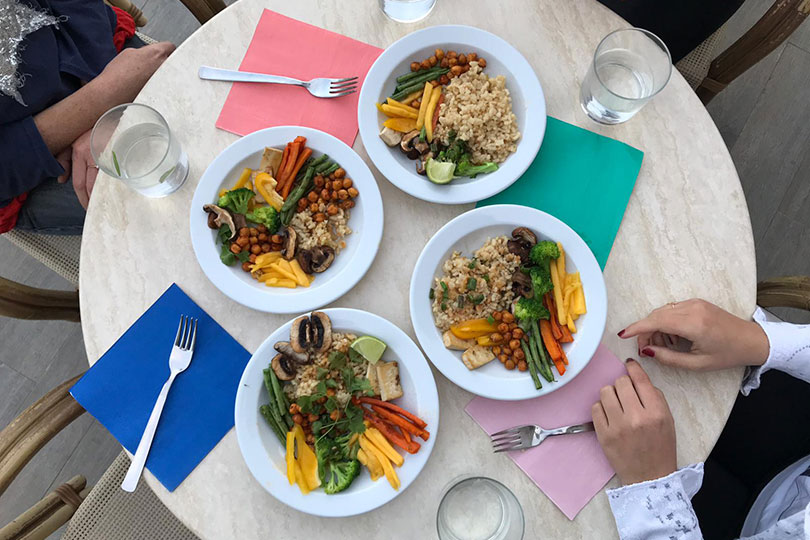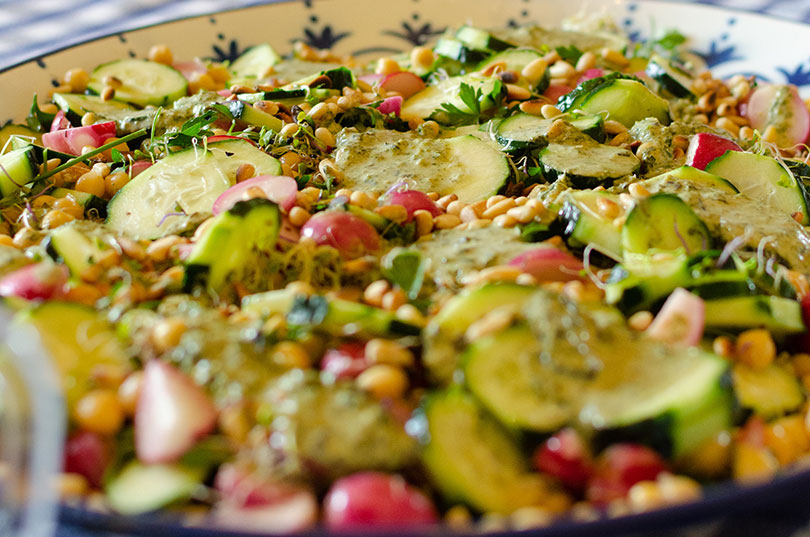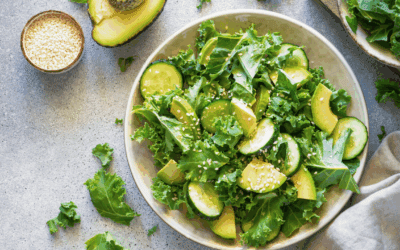The principles of a Sattvic diet have their roots in the dualistic Samkhya philosophy of India, where everything in the manifest universe comprises the three Gunas: Sattva, Rajas and Tamas. The Gunas are the inherent energetic qualities present in all things.
The concept of the Gunas is also found in Ayurveda (from the Sanskrit terms: ‘Ayur’ – life, and ‘Veda’- knowledge), the sister science of yoga. According to this 4000-year-old traditional Indian medicine system, all the foods we eat contain the energetic qualities of the three Gunas, in varying degrees.
The Gunas
The main energetic qualities associated with each are as follows:
Sattva
- Sattva is a state of harmony, purity, balance and joy.
- In practice, it is the balance of all the elements to make us feel at peace and content.
- Sattvic food is freshly prepared and usually cooked, facilitating easy digestion with the goal of nourishing us.
Focus on eating more of these foods:
- Home-cooked food
- Vegetarian food
- Well-cooked grains
- Fresh, locally sourced seasonal vegetables
- Small beans such as lentils and mung beans
Decrease intake of these foods:
- Processed, packaged or frozen foods
- Leftovers
- Old or wilted food
- Onions and garlic
- Restaurant food
- Eggs
- White processed sugar
- Foods that are overly spiced, salty or sour
- Alcohol and drugs
Rajas
- Rajas is a state of change, agitation, energy, and aggression.
- In practice, it is what motivates us and drives us. In excess, it can make us feel aggressive or can lead to burnout.
- Rajasic foods essentially act as stimulants or irritants to the body. These include very spicy or hot food, meat, canned food, refined sugar and coffee.
Focus on eating more of these foods:
- Fresh, seasonal vegetables, especially zucchini, cucumber, watercress and fennel
- Sweet, juicy seasonal fruits
- Fresh herbs such as cilantro and parsley
- Coconut (including the oil, water, milk, sugar and meat of the fruit)
- Small beans such as adzuki, black, lentils and mung
Decrease intake of these foods:
- Stinky cheeses
- Eggs
- Alcohol
- Ferments, including kombucha
- Sour or unripe fruits
- Salty condiments
- Chilli peppers
- Red meat
- Vinegar
- Onions and garlic
- Restaurant food
- Popcorn, chips and crackers
- Smoking
Tamas
- Tamas is a state of stability, slowness, inactivity and lethargy.
- In practice, it is what stabilises us and grounds us. When it is out of balance, it causes us to feel lethargic or unmotivated.
- Tamasic food is over-processed, and difficult to digest, such as fried food, and junk food. Alcohol also falls under this category.
Focus on eating more of these foods:
- Fresh seasonal vegetables, especially greens and leafy greens
- Fresh herbs and spices
- Turmeric
- Raw honey
- Citrus fruits
- Berries
- Light grains, like quinoa, barley, rye and wild rice
- Legumes and seeds
Decrease intake of these foods:
- Stimulants like alcohol and drugs
- Sweets, cookies and candy
- Soft drinks
- Processed snacks, including chips
- Pastries
- Old food and leftovers
- Frozen food
- Meat
- Cold dairy

How do Sattvic foods relate to meditation practice?
When you are trying to move into a quieter mental space, the idea is to remove as many stimulants and irritants as possible. That’s why a Sattvic diet is recommended. Food is lightly flavoured and things such as garlic, onions, meat, hot spices, dairy and refined sugar are left out of the recipes that are prepared. All food should ideally be cooked and served warm as Ayurveda views these foods as ‘predigested’ in a way. If you have any raw food, it is preferable to have these in the middle of the day, when the digestive fire or ‘agni’ is at its strongest.
The most noticeable benefits you’ll experience on a Sattvic diet are:
- Improved digestion
- A clearer mind
- Feeling nourished
- Improved focus
- More energy
- Resetting your tastebuds, so that you’re able to taste and enjoy your food.
At Silent Focus we adhere to a Sattvic diet during our corporate silent retreats; the benefits of eating this diet in conjunction with meditation and silence offer the most profound benefits to the team. We believe it is important to soothe the mind and body by removing as many stimulants as possible to achieve the most effective results. We have created hundreds of recipes over the years to make the most amazing culinary experience possible. You will leave the retreat wanting more Sattvic food and be surprised about how tasty a Sattvic diet can be.
The application of the Gunas in our modern lives
Once you understand the Gunas, you start to notice their influence everywhere. If you’re feeling like a couch potato, then you need a bit of Rajasic energy to get you up and moving, for instance, by going for a run or dancing to your favourite song. If you’re feeling wired and anxious, then you need to slow it down by adding some Tamasic energy to the mix. This could mean going for a walk in nature instead of hitting a high-intensity workout at the gym.
Ultimately, we are trying to return to a Sattvic or balanced state in the physical body, but also emotionally and mentally. As such, everything we consume carries an energetic charge, whether that’s what we’re reading, or watching, who we’re spending our time with or even how we’re exercising. We can determine our baseline energetic state to a large degree by consuming everything, not just our food, more consciously. All of the practices we engage in, such as yoga, meditation, and breathing techniques have this goal in mind to ultimately bring us back into balance, back to a Sattvic state.
Below is one of the Sattvic recipes we use at our corporate silent retreats:
Coconut Soup with Sweet Potato and Kale
- 1 teaspoon coconut oil
- 15 medium portabello mushrooms
- ½ to 1 teaspoon of salt
- 2 cans of coconut milk
- 1 ½ cups water
- 1 tablespoon minced fresh garlic
- 2 large sweet potatoes, chopped
- 1 medium size bunch of cilantro, stems diced, (1/2 cup), leaves chopped
- Zest and juice of 2 limes
- 2 cups loosely packed kale, chopped
- 2 cups cooked brown jasmine rice
Heat the oil in a large pot over medium heat. Add the mushrooms and ½ teaspoon salt and cook, stirring occasionally, for 8 minutes, or until softened.
Stir in the coconut milk, 1½ cups water, ginger, sweet potato and cilantro stems. Simmer over low heat for 20 minutes, or until the sweet potatoes are fork-tender.
Add the lime zest and juice. Taste, then add ½ teaspoon of salt, if desired, add tamari, if using. Add the chopped kale and simmer just until wilted 1 to 2 minutes. Stir in the cilantro leaves just before serving.
Serve with rice dished into the soup or on the side.
For more delicious sattvic recipes make sure you sign up to our newsletter at the bottom of the website.




